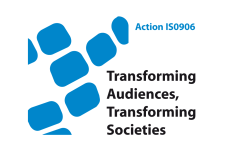- About the Action
- Events
- PhD workshop - Ljubljana 2014
- Action Open Conference - Ljubljana 2014
- New Media and Participation conference - Istanbul 2013
- Belgrade meeting 2013
- Media literacy research and policy - Brussels 2013
- ICA Pre-Conference 2013
- Tampere meeting 2013
- Budapest workshop 2012
- Milan meeting 2012
- Brussels PhD workshop 2012
- Brussels Action workshop 2012
- London meeting 2011
- Zagreb Conference 2011
- Lisbon meeting 2010
- Affiliated events
- WG 1
- WG 2
- WG 3
- WG 4
- Cross-WG
- Output
Online/offline patterns of belonging: learning from religion
Lundby, K. (2011). Online/offline patterns of belonging: learning from religion . Zagreb conference: "New challenges and methodological innovations in European media audience research". 7-9 April 2011.
Abstract: Lorne Dawson’s piece on ‘Religion and the Quest for Virtual Community’ (2004) is a landmark in the ‘second wave’ of research on religion and the Internet (Højsgaard & Warburg 2005; Campbell 2011) that corresponds to the ‘second age’ of Internet studies in general (Wellman 2011). Dawson observed that ‘the larger framework of our social lives is now the social network more than the community as traditionally conceived’ (2004, p.85). This paper explores patterns of belonging that may develop at the interface of online and offline activities, with reference to Dawson’s essay. ‘Belonging’ is the key to unlock the online/offline relations; the conceptual tool to link ‘community’ and ‘networks’. Patterns of belonging are understood through processes of interaction and identification. Online belongings are cultural practices (Ferreday 2009) linking with cultural belonging offline (Therborn 1991). Belonging emerges through interplay between the social and material realm mediated through culture (Jansson 2009), of which religion is a part. Religion is here defined through processes of mediation (Meyer & Moors 2006) and patterns of belonging. Online patterns are considered in relation to offline structures. The author suggests a typology where patterns of religious belonging could be traced either as ‘participatory’ or ‘vicarious’ (Davie 2007, 2010), online or offline, respectively. The Internet as available with the affordances of social media – in the open exchange between the online and offline – offers new ways for religion to happen. Forms of religion and religiosity are shaped through the interplay of mediation and belonging at the offline/online interface.

